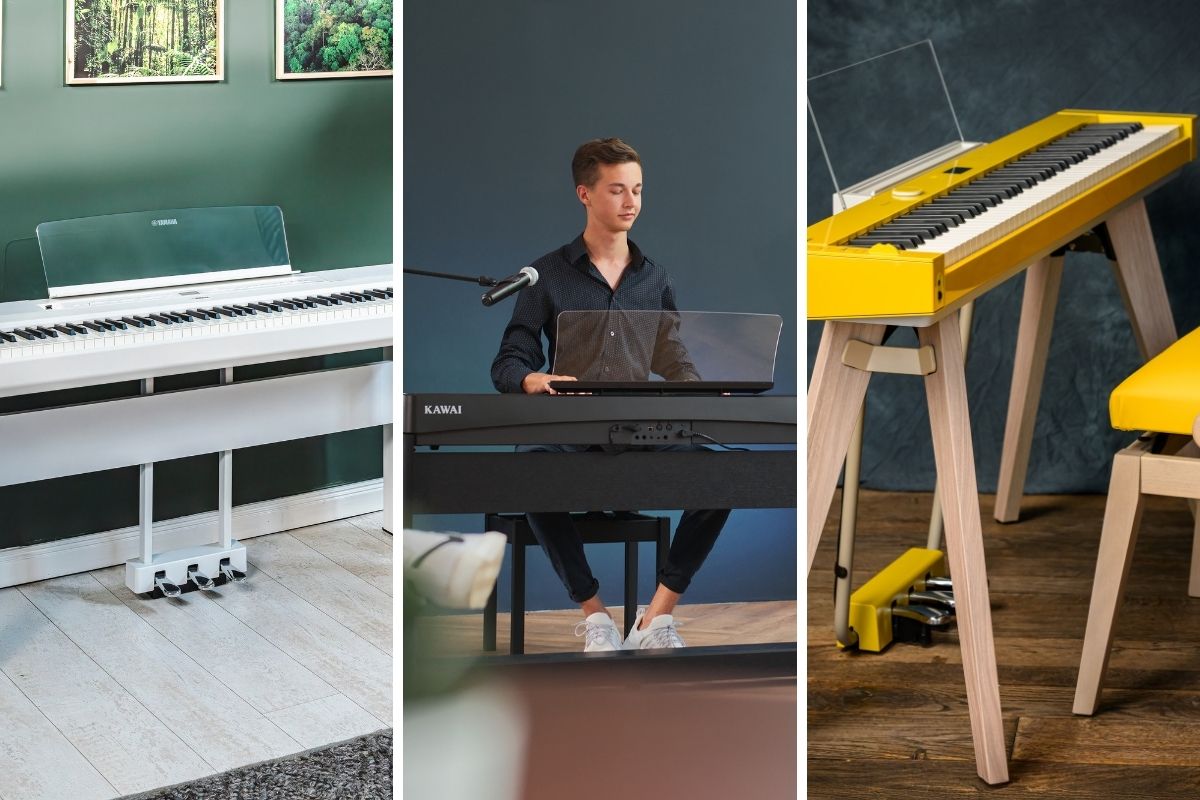
Comparing the Best Flagship Portable Pianos 2025: Kawai ES920 vs Yamaha P-525 vs Roland FP-90X
|
|
Time to read 4 min
|
|
Time to read 4 min
Whether you're a gigging musician, a serious hobbyist, or looking to invest in a long-term home instrument without sacrificing portability, the flagship portable piano market offers several compelling choices. In this article, we compare Kawai’s ES920 , Yamaha’s P-525 , Roland’s FP-90X , and also weigh in on some wildcards that you might not have considered with Casio’s PX-S6000 and PX-S7000 , which blend style and innovation with serious sound capabilities.
Table of contents
| Feature | Kawai ES920 | Yamaha P-525 | Roland FP-90X | Casio PX-S6000 | Casio PX-S7000 |
|---|---|---|---|---|---|
| Key Action | Responsive Hammer III (RHIII) | GrandTouch-S with wooden keys | PHA-50 (Hybrid) | Smart Hybrid Hammer | Smart Hybrid Hammer |
| Sound Engine | Harmonic Imaging XL | CFX & Bösendorfer | PureAcoustic Piano Modeling | Multi-Dimensional Morphing AiR | Multi-Dimensional Morphing AiR |
| Polyphony | 256 notes | 256 notes | Unlimited (piano), 256 max | 256 notes | 256 notes |
| Speakers | 40W (2x20W) | 40W (2x20W) | 60W (2x25W + 2x5W tweeters) | 32W | 32W |
| Weight | 37 lbs / 17 kg | 48.5 lbs / 22 kg | 52 lbs / 23.6 kg | 32 lbs / 14.5 kg | 32 lbs / 14.5 kg |
| Price Range | ~$1,700 | ~$1,900 | ~$2,200 | ~$1,800 | ~$2,200 |
Kawai ES920 uses RHIII , a well-regarded plastic key action with triple sensor, counterweights, and let-off simulation. While not wooden, it’s responsive and nuanced.
Yamaha P-525 steps up with GrandTouch-S , using real wood white keys and refined escapement, closely mimicking a grand piano. The action is heavier than Kawai's, favoring classical pianists.
Roland FP-90X features PHA-50 , a hybrid action with wooden sides and plastic core. It feels solid and durable, with excellent balance.
Casio PX-S6000/PX-S7000 use Smart Hybrid Hammer Action , incorporating wooden elements with slim key profiles. Their feel is surprisingly good for their size, though lighter than Yamaha or Roland.
📝 Verdict: Yamaha and Roland offer the most realistic action but this comes at the cost of weight; Kawai is great for speed and control; Casio strikes a balance between compact form and quality feel.
Kawai ES920 uses Harmonic Imaging XL , offering lush, warm samples from the Shigeru Kawai SK-EX grand. Great for classical and romantic repertoire.
Yamaha P-525 uses CFX and Bösendorfer Imperial samples, delivering a bright, projecting sound (CFX) and warm, singing tones (Bösendorfer).
Roland FP-90X with its PureAcoustic Modeling means no samples, entirely modeled. It provides a very different experience, inifinitely configurable..
Casio PX-S6000/7000 use Multi-Dimensional Morphing AiR , now enhanced with vivid resonance modeling. Their pianos are clear, resonant, and dynamic, though less complex than Roland's modeling.
📝 Verdict: Roland’s modeled engine stands out for the ability to configure; Yamaha for its tonal variety; Kawai for its elegant warmth; Casio for balance and portability.
Yamaha P-525 and Kawai ES920 both pack 40W , enough for home use or small gigs.
Casio PX-S6000/7000 offer 32W systems but with smart speaker placement that enhances stereo imaging.
📝 Verdict: Roland dominates here, especially for solo performance without external amplification.
Kawai ES920 is the lightest among premium models at 37 lbs —a gigging favorite.
Yamaha P-525 and Roland FP-90X are significantly heavier, edging into “semi-portable” territory.
Casio PX-S6000/7000 are the most compact full-featured models, perfect for home or travel, and visually stunning with wooden accents.
📝 Verdict: Casio wins on form factor and aesthetic; Kawai offers the best weight-to-feature ratio.
Roland FP-90X includes Bluetooth Audio & MIDI , USB Audio, and 1/4" outputs—ideal for performance and streaming.
Yamaha P-525 has Bluetooth MIDI , USB-to-host/audio, and full MIDI I/O—excellent for MIDI integration.
Kawai ES920 features Bluetooth Audio & MIDI , and a solid app interface.
Casio PX-S6000/7000 offer advanced Bluetooth Audio , app integration (via Casio Music Space), and customizable tones.
📝 Verdict: Roland and Casio have the edge in Bluetooth features; Yamaha offers the most versatile MIDI setup.
While not traditional “stage pianos,” the PX-S6000 and PX-S7000 aim for aesthetic-forward design with pro-level performance that may be considered by some as flagship portable pianos. The PX-S7000 includes an integrated stand, triple pedal unit, and high-end finishes, while the PX-S6000 offers more flexibility for portability.
These Casios are ideal for players who value:
Modern home decor integration
Lightweight portability with premium sound
Intuitive controls and touchscreen UI
They might lack the raw acoustic realism of Roland or Yamaha, but for lifestyle-focused musicians, they’re an excellent alternative.
Classical Pianist: Yamaha P-525 for the wooden keys and dual grand samples
Performer/Gigging Artist: Kawai ES920 (lightweight)
Studio/Recording: Roland FP-90X for modeling flexibility and I/O
Design-Focused Home Use: Casio PX-S7000 and take out for occasional use
Budget-Conscious Advanced Player: Kawai ES920 offers strong value or try the Casio PX-S6000
Our Cambridge city centre showroom is the perfect place to visit, one of the top shopping destinations in the UK with world class sights, restaurants, cafes, and shopping.
We stock the leading range of digital, hybrid, acoustic, silent, upright, and grand pianos in our beautiful Cambridge showroom.
With our highly-trained demonstrators you can explore the range, compare models, and make the right choice.
All five of these digital pianos represent the pinnacle of portable piano performance . Choosing the right one depends on your playing style , portability needs , sound preferences , and even your living space aesthetics .
Want acoustic realism and tonal control? Go with Roland FP-90X .
Prefer a dynamic, expressive touch? Try Yamaha P-525 .
Need something lightweight and consistent? Kawai ES920 is a top pick.
Love modern design and flexible features? Casio PX-S6000/7000 might surprise you.